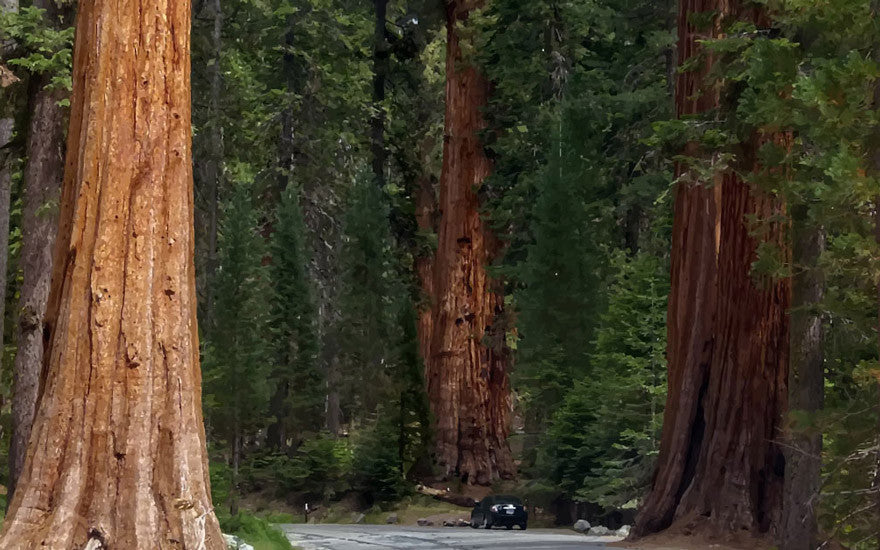Giants in the Land

Did you know the tallest living trees would actually look down on the Statue of Liberty and England’s Big Ben if they stood side-by-side with these famous landmarks? In fact, many of the giant redwoods of California stand significantly over 300 feet tall. As the tallest trees found anywhere on earth, they are really quite special – it’s no wonder President Benjamin Harrison gave them permanent protection by establishing what’s now called the Sequoia National Park, thus ensuring that their majesty could be preserved and enjoyed for the last 125 years and counting.
Fun Facts
- Sequoia National Park is America’s second national park and was established 125 years ago, in 1890!
- The largest tree (by volume) in the world is a giant sequoia named General Sherman, located in Sequoia National Park. It stands at 274.9 feet tall and weighs a staggering 2.7 million pounds.
- The top five largest trees in the world are all found in Sequoia National Park[i]!
- The tallest tree in the world is also found in California and is a coastal redwood species named Hyperion. Hyperion stands over 100 feet taller than General Sherman. Hyperion’s total height – a shocking 379.7 feet!

General Sherman – The Largest Tree in the World
How old are the Giant Sequoias?
These trees are really, really old. In fact, the sequoias are believed to be the third-longest living tree species in the world, with at least one particular tree believed to be over 3,200 years old[ii]!
Some secular scientists have used the tree age study to challenge a literal account of Genesis, and thus the biblical timeline. More recently however, secular scientists are revising the age of certain tree species (including the giant sequoia and coastal redwoods) to reflect a significantly younger age. In fact, in almost every case, including a study on the oldest trees on earth, the bristlecone pines, show that oldest living trees are all in the 4,000 year-old range[iii].
Why Don’t we Find Older Trees?
The biblical timeline suggests that Noah’s flood covered the surface of earth some 4,500 years ago (Genesis 7). The cohesive timeline between the biblical study and tree age study lends strong credence for the biblical flood as being the reason why we don’t find older trees.
Why Do Scientists Keep Revising the Age of Ancient Trees?
Using the ring-count method, the Giant Grizzly tree in Yosemite was once believed by the National Parks Service to be at least 2,700 years old. It has since been revised to an estimated 1,900 years old. Furthermore, the famous General Sherman was believed to be 3,000+ years old, but was most recently revised to 2,150.[iv] With estimates fluctuating nearly 30% and average ages trending downward, it’s reasonable to conclude that age dating by ring count is at best, imperfect. Nevertheless, age dating by ring count is the more accurate method used and does give us a rough idea as to the age of these ancient giants.
How are They Able to Live so Long?
The impressive longevity of the sequoia is credited to its highly specialized features that inherently protect it from trees’ natural vulnerabilities, namely disease, insects, and fire. Its most prominent defense feature is its bark, often found to be 24-31” thick, which is thicker than any other tree on earth. The thickness of the bark combined with its soft, water-absorbing core help protect it from wildfires. Additionally, the sequoia’s bark contains a bitter tasting organic substance known as tannin, which is a natural repellent to insects like termites.
Giant Sequoias Only Found in California?
The giant sequoias thrive in their higher-elevation habitat in the Sierra Nevada Mountains of California. Resting primarily between 5,000 and 7,000 feet in elevation, the periodic dry spells and seasonal rainfall make near perfect climatic conditions for a little seedling to take root and flourish. Even though California is now an ideal habitat for the sequoias, there does remain some evidence that the sequoia towered over its counterparts as far as 400 miles from the slopes of Sierra Nevada’s. Fossil discoveries found in Utah and Nevada in the last 50 years have included sequoia leaves and cones[v], suggesting that they once weren’t only restricted to the Sierra Nevada mountain range.
Summing Up
Few of the wonders of nature are as impressive as these monuments of antiquity. To put it into perspective, it’s reasonable to assume that many of them stood where they remain today in the post-flood days of Noah. Therefore, we can surmise that the ages of these ancient California giants align beautifully with the timeline of Noah’s Flood recorded in the book of Genesis.
[i] http://traveltips.usatoday.com/general-sherman-tree-61028.html
[ii] http://www.nps.gov/yose/learn/nature/sequoia-research.htm
[iii] http://www.icr.org/article/can-redwoods-date-flood/
[iv] http://www.nps.gov/yose/learn/nature/upload/Sequoia-aging-2000.pdf
[v] http://www.nps.gov/parkhistory/online_books/science/hartesveldt/chap3.htm
1 Response
Leave a comment
Comments will be approved before showing up.




Faylinn
June 15, 2016
I had no idea that some of the giant redwood trees in California stand over 300 feet tall. For some reason, I thought that they would stand at most only 200 feet tall, but the Hyperion is definitely almost double that height. However, what does a tree’s height have to say about its age? I’m just curious because supposedly some can be an unbelievably 3,200-years-old. http://www.ablescape.com